Building Economics: Cost-Benefit Analysis and Recommendations
VerifiedAdded on 2022/09/26
|23
|4315
|30
Report
AI Summary
This report provides a comprehensive analysis of two building construction options for a client, focusing on building economics and cost-benefit analysis. The options include a two-story building with a separate gym and a three-story building with an integrated gym. The report outlines the objectives, methodology, and a detailed comparison of the two options, considering factors like construction costs, potential income from rentals and sales (including office rentals and gym revenue), and the impact of design on overall project costs. The analysis includes component ratios for each project, consideration of ground conditions, and the impact of environmental factors. The report concludes with a recommendation for the client, based on the cost-benefit analysis and potential revenue generation, along with a discussion of constructability and the importance of early-stage planning. The report also includes tables showing the percentage breakdown of components for each option, detailing traffic management, environmental protection, and drainage. The report aims to guide the client in making an informed decision that minimizes costs and maximizes project viability.
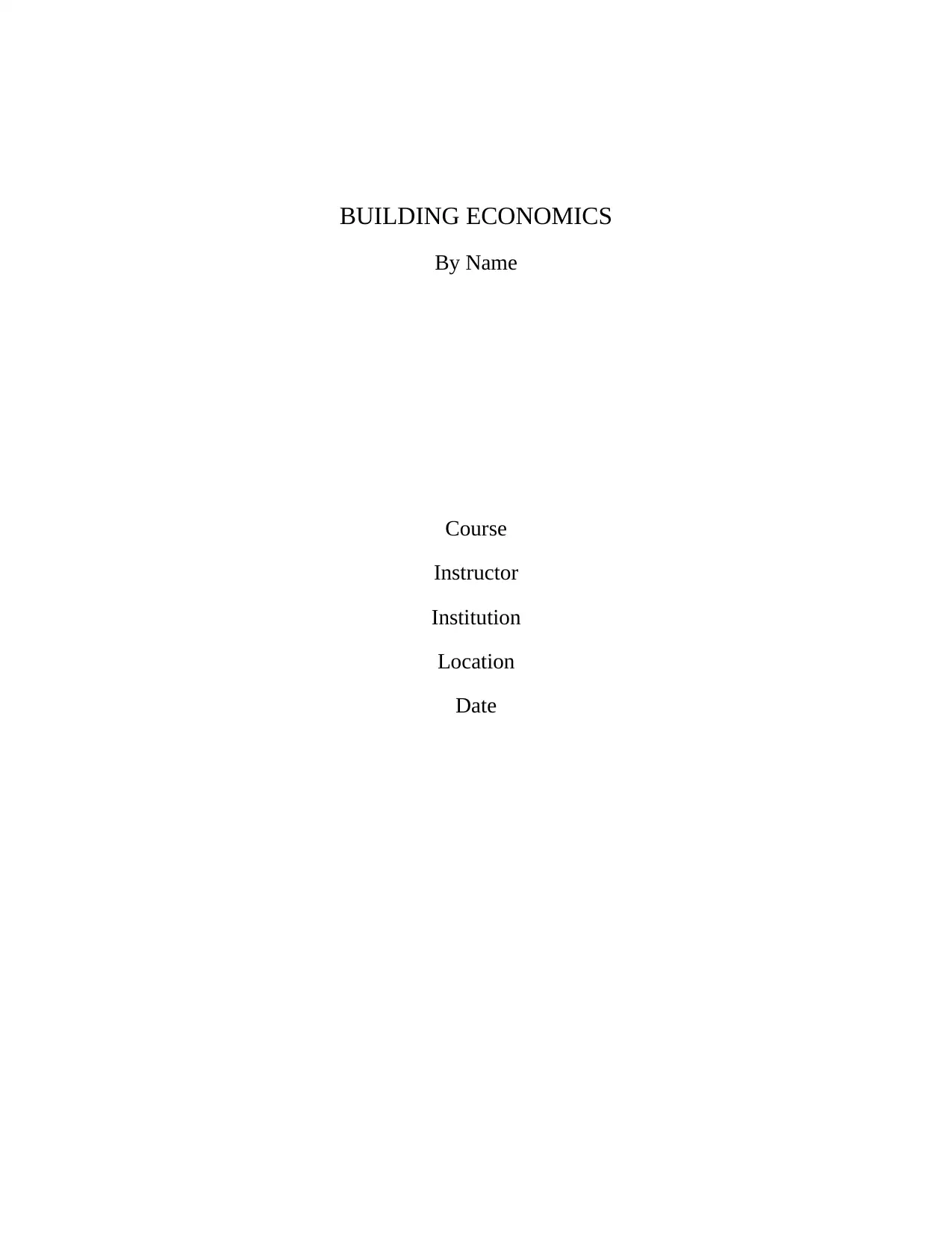
BUILDING ECONOMICS
By Name
Course
Instructor
Institution
Location
Date
By Name
Course
Instructor
Institution
Location
Date
Paraphrase This Document
Need a fresh take? Get an instant paraphrase of this document with our AI Paraphraser
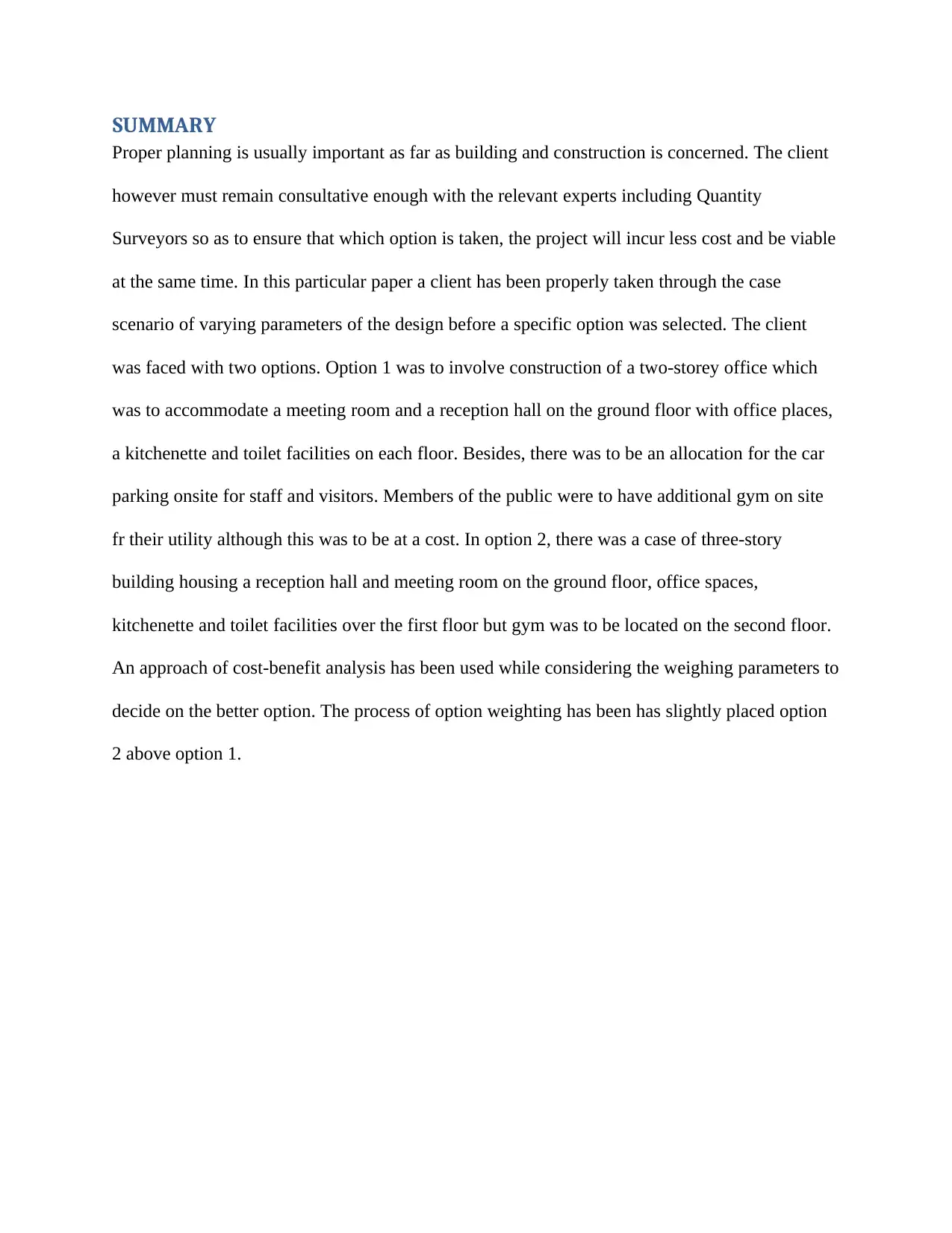
SUMMARY
Proper planning is usually important as far as building and construction is concerned. The client
however must remain consultative enough with the relevant experts including Quantity
Surveyors so as to ensure that which option is taken, the project will incur less cost and be viable
at the same time. In this particular paper a client has been properly taken through the case
scenario of varying parameters of the design before a specific option was selected. The client
was faced with two options. Option 1 was to involve construction of a two-storey office which
was to accommodate a meeting room and a reception hall on the ground floor with office places,
a kitchenette and toilet facilities on each floor. Besides, there was to be an allocation for the car
parking onsite for staff and visitors. Members of the public were to have additional gym on site
fr their utility although this was to be at a cost. In option 2, there was a case of three-story
building housing a reception hall and meeting room on the ground floor, office spaces,
kitchenette and toilet facilities over the first floor but gym was to be located on the second floor.
An approach of cost-benefit analysis has been used while considering the weighing parameters to
decide on the better option. The process of option weighting has been has slightly placed option
2 above option 1.
Proper planning is usually important as far as building and construction is concerned. The client
however must remain consultative enough with the relevant experts including Quantity
Surveyors so as to ensure that which option is taken, the project will incur less cost and be viable
at the same time. In this particular paper a client has been properly taken through the case
scenario of varying parameters of the design before a specific option was selected. The client
was faced with two options. Option 1 was to involve construction of a two-storey office which
was to accommodate a meeting room and a reception hall on the ground floor with office places,
a kitchenette and toilet facilities on each floor. Besides, there was to be an allocation for the car
parking onsite for staff and visitors. Members of the public were to have additional gym on site
fr their utility although this was to be at a cost. In option 2, there was a case of three-story
building housing a reception hall and meeting room on the ground floor, office spaces,
kitchenette and toilet facilities over the first floor but gym was to be located on the second floor.
An approach of cost-benefit analysis has been used while considering the weighing parameters to
decide on the better option. The process of option weighting has been has slightly placed option
2 above option 1.

Contents
SUMMARY...................................................................................................................................................2
INTRODUCTION...........................................................................................................................................4
OBJECTIVES..................................................................................................................................................4
METHODOLOGY...........................................................................................................................................5
Option 1...................................................................................................................................................5
A two-storey office building:...................................................................................................................5
Option 2...................................................................................................................................................6
A three-storey building:...........................................................................................................................6
Cost-benefit Analysis...............................................................................................................................7
How design of option 2 will impact the cost of construction in comparison with option 1.....................9
RESULTS AND DISCUSSION........................................................................................................................10
Component ratio for the Item in Project 1........................................................................................10
Project 2 Component Ratio of Item.......................................................................................................12
Impact of the ground conditions on the site:........................................................................................14
Extra foundation Operation – Time and Cost........................................................................................15
Car Battery Contamination Management..........................................................................................16
Option to be taken by the Client...........................................................................................................17
CONCLUSION.............................................................................................................................................18
REFERENCES..............................................................................................................................................20
SUMMARY...................................................................................................................................................2
INTRODUCTION...........................................................................................................................................4
OBJECTIVES..................................................................................................................................................4
METHODOLOGY...........................................................................................................................................5
Option 1...................................................................................................................................................5
A two-storey office building:...................................................................................................................5
Option 2...................................................................................................................................................6
A three-storey building:...........................................................................................................................6
Cost-benefit Analysis...............................................................................................................................7
How design of option 2 will impact the cost of construction in comparison with option 1.....................9
RESULTS AND DISCUSSION........................................................................................................................10
Component ratio for the Item in Project 1........................................................................................10
Project 2 Component Ratio of Item.......................................................................................................12
Impact of the ground conditions on the site:........................................................................................14
Extra foundation Operation – Time and Cost........................................................................................15
Car Battery Contamination Management..........................................................................................16
Option to be taken by the Client...........................................................................................................17
CONCLUSION.............................................................................................................................................18
REFERENCES..............................................................................................................................................20
⊘ This is a preview!⊘
Do you want full access?
Subscribe today to unlock all pages.

Trusted by 1+ million students worldwide

INTRODUCTION
The concept of Constructability has been used as an approach of linking the construction and
design process and has the potential of time and cost saving which are crucial factors in the
completion of construction projects. It is the primary responsibility of all the project stakeholders
including contractors, designers and owners to improve the Constructability. However, it is
important to note that the client has the most authority in the enforcement of Constructability
implementation. The owners of the project must be fully aware of the decisions which form part
of the planning in the initial stages which are usually difficult to subject to changes once the
process of construction has been started. The Constructability input method used was actually
determined by the selection project by the owners. The involvement of the construction experts’
particular surveyors and contractors assist in the identification of the possible challenges early
enough so that necessary adjustments can be made hence effective performance of the project
(Kabaya et al.2019).
OBJECTIVES
The primary objective of this particular report to offer pieces of technical advice to the client
faced with two available options for the redevelopment a sloping site which was formerly used
for the battery manufacturing plant.
The concept of Constructability has been used as an approach of linking the construction and
design process and has the potential of time and cost saving which are crucial factors in the
completion of construction projects. It is the primary responsibility of all the project stakeholders
including contractors, designers and owners to improve the Constructability. However, it is
important to note that the client has the most authority in the enforcement of Constructability
implementation. The owners of the project must be fully aware of the decisions which form part
of the planning in the initial stages which are usually difficult to subject to changes once the
process of construction has been started. The Constructability input method used was actually
determined by the selection project by the owners. The involvement of the construction experts’
particular surveyors and contractors assist in the identification of the possible challenges early
enough so that necessary adjustments can be made hence effective performance of the project
(Kabaya et al.2019).
OBJECTIVES
The primary objective of this particular report to offer pieces of technical advice to the client
faced with two available options for the redevelopment a sloping site which was formerly used
for the battery manufacturing plant.
Paraphrase This Document
Need a fresh take? Get an instant paraphrase of this document with our AI Paraphraser

METHODOLOGY
Quantity surveyors are therefore expected to provide precise estimates for the projects
considering the available terms and conditions set the client. The instruction or pieces of advice
given to the client should consider the prevailing environmental and geological characteristics of
the site. In this particular case, the client is exposed to at least two viable options. However, it is
expected that proper enlighten is given to the client so that he/she can make an informed
decision. These options included:
Option 1
A two-storey office building:
This will be expected to effectively accommodate a meeting room and a reception hall on
the ground floor.
It will have office space, a kitchenette as well as facilities of the toilet on each and every
floor.
It will have an onsite car park for visitors and staff
A state-of-the-art gym for use by members of the public and this will be generating extra
revenue
Figure 1: Angle view
Quantity surveyors are therefore expected to provide precise estimates for the projects
considering the available terms and conditions set the client. The instruction or pieces of advice
given to the client should consider the prevailing environmental and geological characteristics of
the site. In this particular case, the client is exposed to at least two viable options. However, it is
expected that proper enlighten is given to the client so that he/she can make an informed
decision. These options included:
Option 1
A two-storey office building:
This will be expected to effectively accommodate a meeting room and a reception hall on
the ground floor.
It will have office space, a kitchenette as well as facilities of the toilet on each and every
floor.
It will have an onsite car park for visitors and staff
A state-of-the-art gym for use by members of the public and this will be generating extra
revenue
Figure 1: Angle view

Figure 2:Front view
Option 2
A three-storey building:
Has only meeting room and reception hall located on the ground floor
First floor has toilet facilities, office spaces and kitchenette.
Second floor has the gym
NB: This will lead to smaller footprint as well as increasing the area of parking for the
customers, staff and visitors.
Figure 3: Angle view
Option 2
A three-storey building:
Has only meeting room and reception hall located on the ground floor
First floor has toilet facilities, office spaces and kitchenette.
Second floor has the gym
NB: This will lead to smaller footprint as well as increasing the area of parking for the
customers, staff and visitors.
Figure 3: Angle view
⊘ This is a preview!⊘
Do you want full access?
Subscribe today to unlock all pages.

Trusted by 1+ million students worldwide
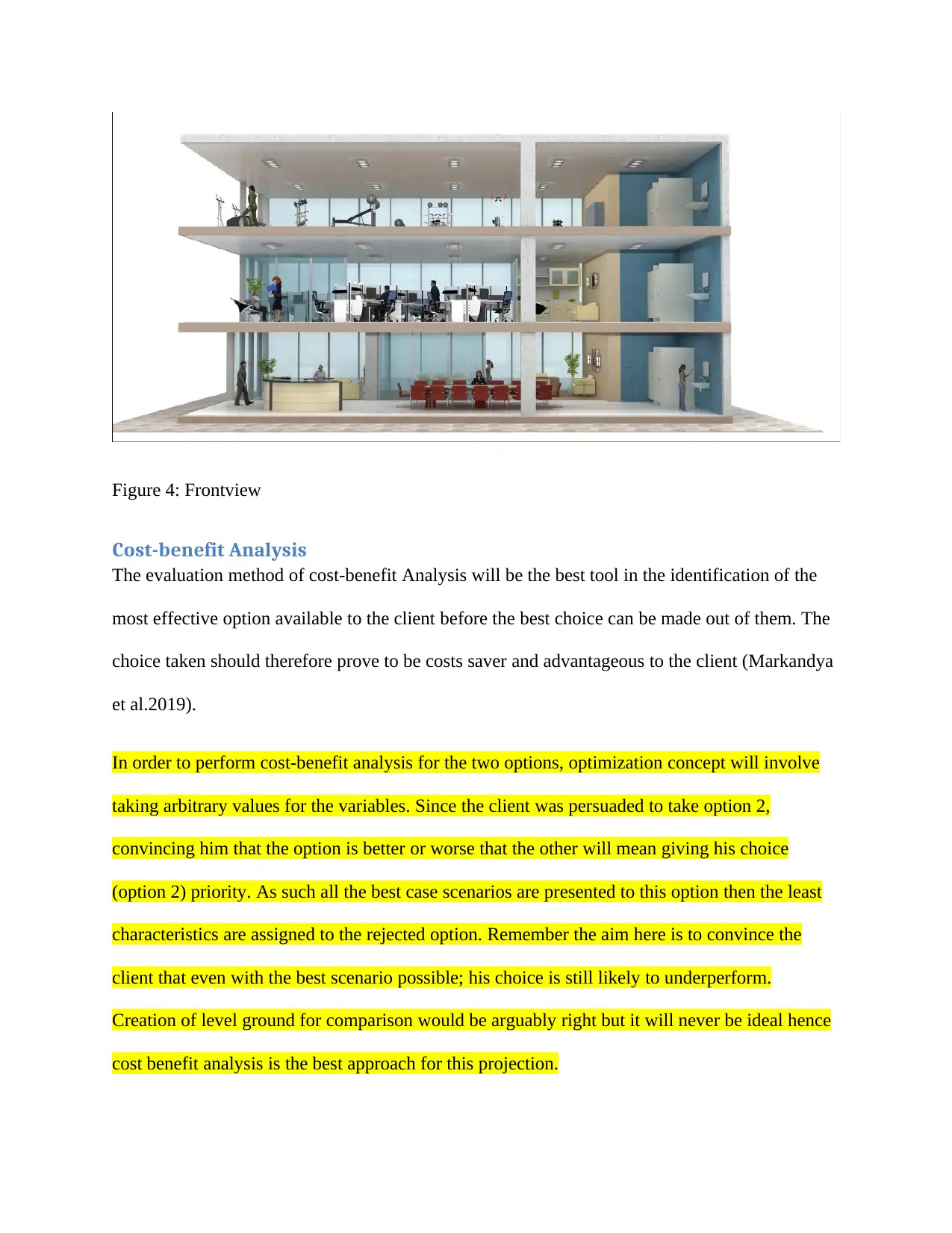
Figure 4: Frontview
Cost-benefit Analysis
The evaluation method of cost-benefit Analysis will be the best tool in the identification of the
most effective option available to the client before the best choice can be made out of them. The
choice taken should therefore prove to be costs saver and advantageous to the client (Markandya
et al.2019).
In order to perform cost-benefit analysis for the two options, optimization concept will involve
taking arbitrary values for the variables. Since the client was persuaded to take option 2,
convincing him that the option is better or worse that the other will mean giving his choice
(option 2) priority. As such all the best case scenarios are presented to this option then the least
characteristics are assigned to the rejected option. Remember the aim here is to convince the
client that even with the best scenario possible; his choice is still likely to underperform.
Creation of level ground for comparison would be arguably right but it will never be ideal hence
cost benefit analysis is the best approach for this projection.
Cost-benefit Analysis
The evaluation method of cost-benefit Analysis will be the best tool in the identification of the
most effective option available to the client before the best choice can be made out of them. The
choice taken should therefore prove to be costs saver and advantageous to the client (Markandya
et al.2019).
In order to perform cost-benefit analysis for the two options, optimization concept will involve
taking arbitrary values for the variables. Since the client was persuaded to take option 2,
convincing him that the option is better or worse that the other will mean giving his choice
(option 2) priority. As such all the best case scenarios are presented to this option then the least
characteristics are assigned to the rejected option. Remember the aim here is to convince the
client that even with the best scenario possible; his choice is still likely to underperform.
Creation of level ground for comparison would be arguably right but it will never be ideal hence
cost benefit analysis is the best approach for this projection.
Paraphrase This Document
Need a fresh take? Get an instant paraphrase of this document with our AI Paraphraser
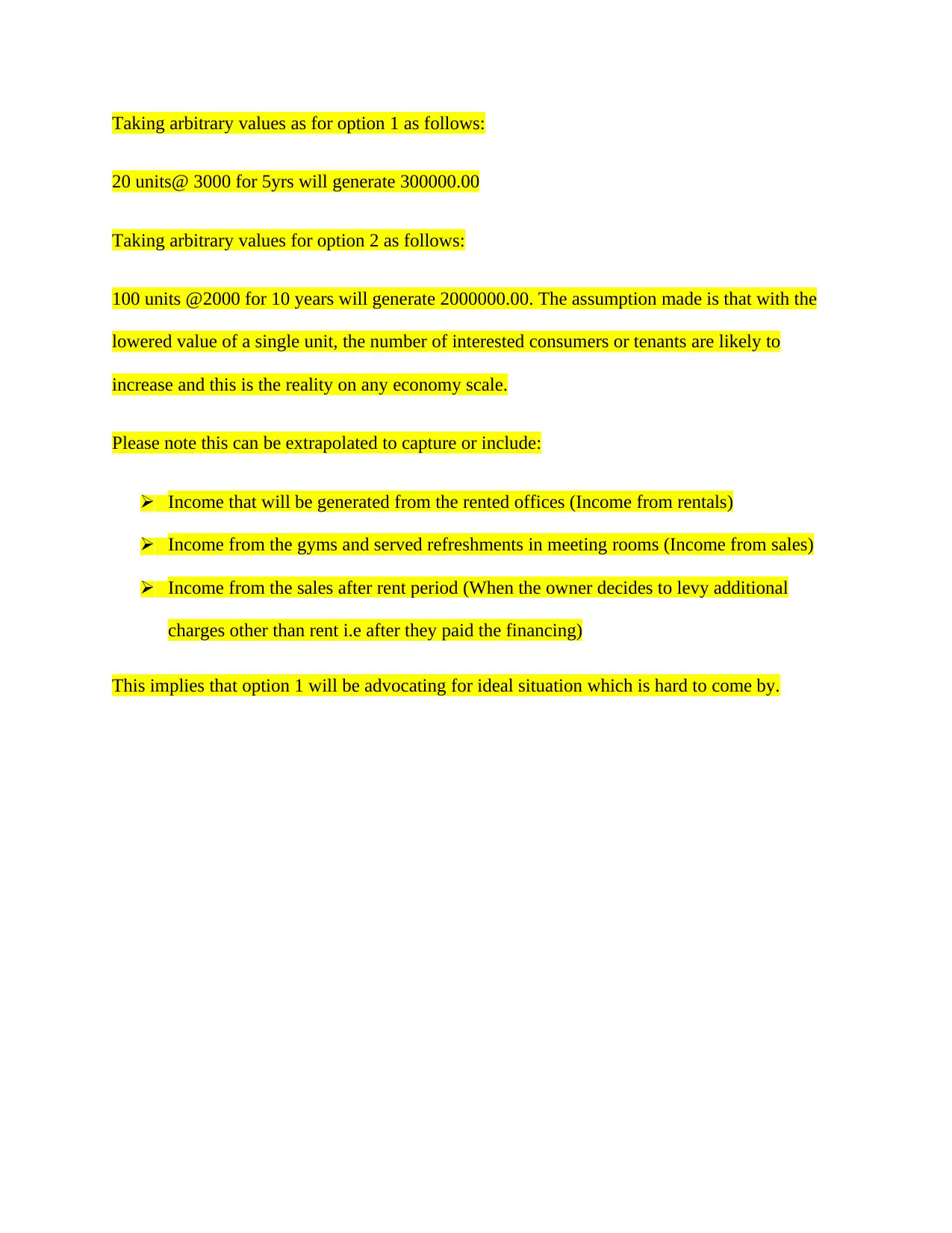
Taking arbitrary values as for option 1 as follows:
20 units@ 3000 for 5yrs will generate 300000.00
Taking arbitrary values for option 2 as follows:
100 units @2000 for 10 years will generate 2000000.00. The assumption made is that with the
lowered value of a single unit, the number of interested consumers or tenants are likely to
increase and this is the reality on any economy scale.
Please note this can be extrapolated to capture or include:
Income that will be generated from the rented offices (Income from rentals)
Income from the gyms and served refreshments in meeting rooms (Income from sales)
Income from the sales after rent period (When the owner decides to levy additional
charges other than rent i.e after they paid the financing)
This implies that option 1 will be advocating for ideal situation which is hard to come by.
20 units@ 3000 for 5yrs will generate 300000.00
Taking arbitrary values for option 2 as follows:
100 units @2000 for 10 years will generate 2000000.00. The assumption made is that with the
lowered value of a single unit, the number of interested consumers or tenants are likely to
increase and this is the reality on any economy scale.
Please note this can be extrapolated to capture or include:
Income that will be generated from the rented offices (Income from rentals)
Income from the gyms and served refreshments in meeting rooms (Income from sales)
Income from the sales after rent period (When the owner decides to levy additional
charges other than rent i.e after they paid the financing)
This implies that option 1 will be advocating for ideal situation which is hard to come by.
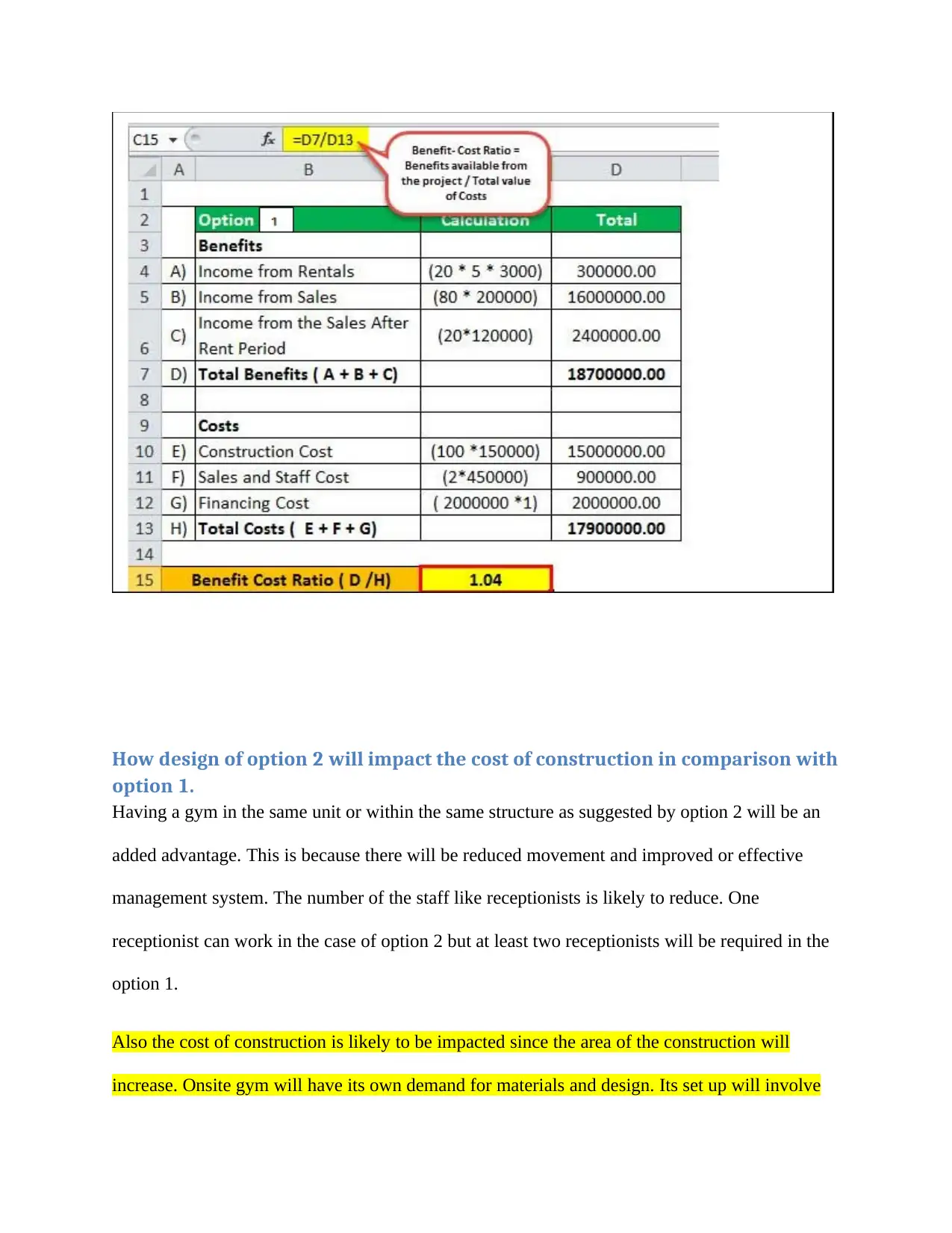
How design of option 2 will impact the cost of construction in comparison with
option 1.
Having a gym in the same unit or within the same structure as suggested by option 2 will be an
added advantage. This is because there will be reduced movement and improved or effective
management system. The number of the staff like receptionists is likely to reduce. One
receptionist can work in the case of option 2 but at least two receptionists will be required in the
option 1.
Also the cost of construction is likely to be impacted since the area of the construction will
increase. Onsite gym will have its own demand for materials and design. Its set up will involve
option 1.
Having a gym in the same unit or within the same structure as suggested by option 2 will be an
added advantage. This is because there will be reduced movement and improved or effective
management system. The number of the staff like receptionists is likely to reduce. One
receptionist can work in the case of option 2 but at least two receptionists will be required in the
option 1.
Also the cost of construction is likely to be impacted since the area of the construction will
increase. Onsite gym will have its own demand for materials and design. Its set up will involve
⊘ This is a preview!⊘
Do you want full access?
Subscribe today to unlock all pages.

Trusted by 1+ million students worldwide
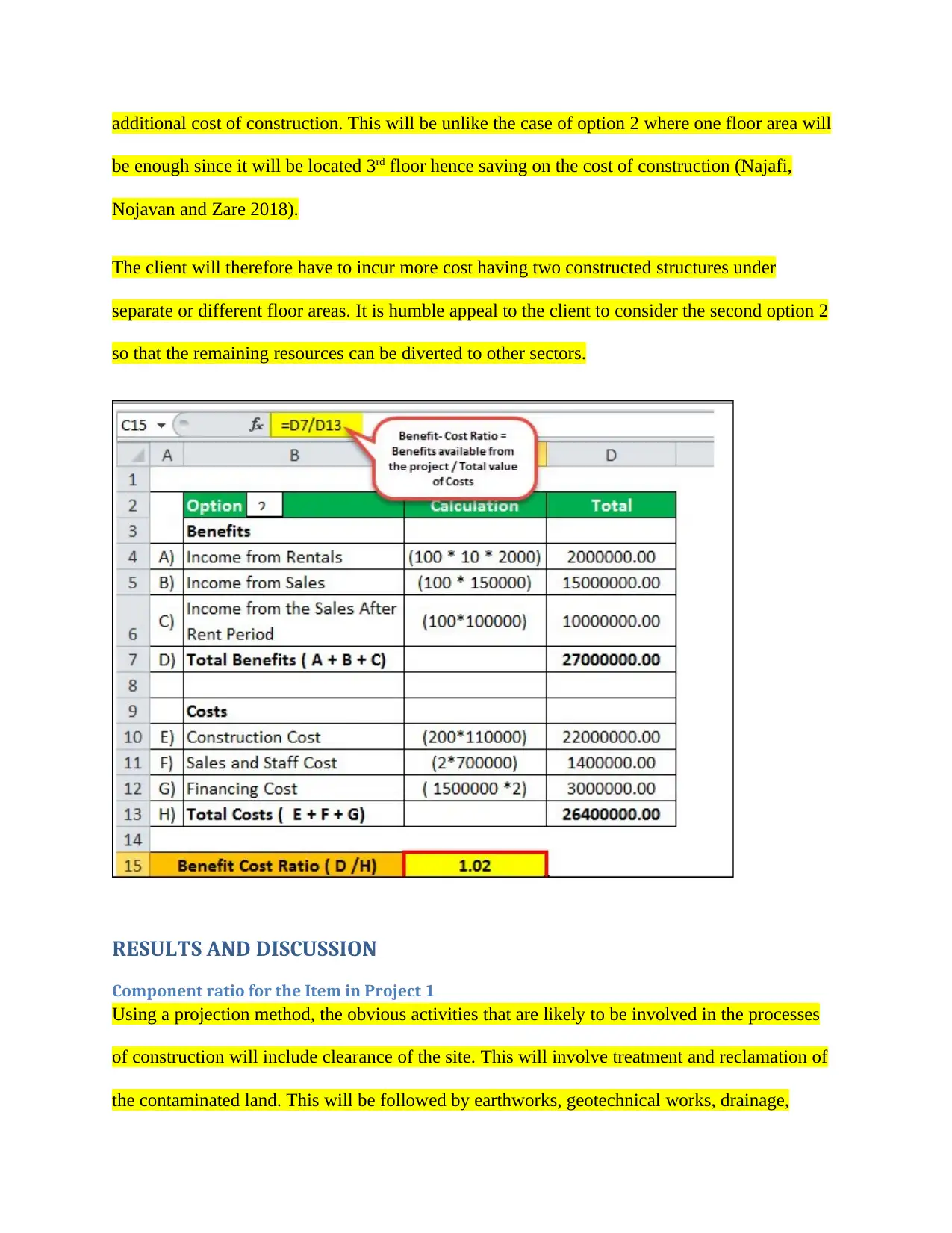
additional cost of construction. This will be unlike the case of option 2 where one floor area will
be enough since it will be located 3rd floor hence saving on the cost of construction (Najafi,
Nojavan and Zare 2018).
The client will therefore have to incur more cost having two constructed structures under
separate or different floor areas. It is humble appeal to the client to consider the second option 2
so that the remaining resources can be diverted to other sectors.
RESULTS AND DISCUSSION
Component ratio for the Item in Project 1
Using a projection method, the obvious activities that are likely to be involved in the processes
of construction will include clearance of the site. This will involve treatment and reclamation of
the contaminated land. This will be followed by earthworks, geotechnical works, drainage,
be enough since it will be located 3rd floor hence saving on the cost of construction (Najafi,
Nojavan and Zare 2018).
The client will therefore have to incur more cost having two constructed structures under
separate or different floor areas. It is humble appeal to the client to consider the second option 2
so that the remaining resources can be diverted to other sectors.
RESULTS AND DISCUSSION
Component ratio for the Item in Project 1
Using a projection method, the obvious activities that are likely to be involved in the processes
of construction will include clearance of the site. This will involve treatment and reclamation of
the contaminated land. This will be followed by earthworks, geotechnical works, drainage,
Paraphrase This Document
Need a fresh take? Get an instant paraphrase of this document with our AI Paraphraser
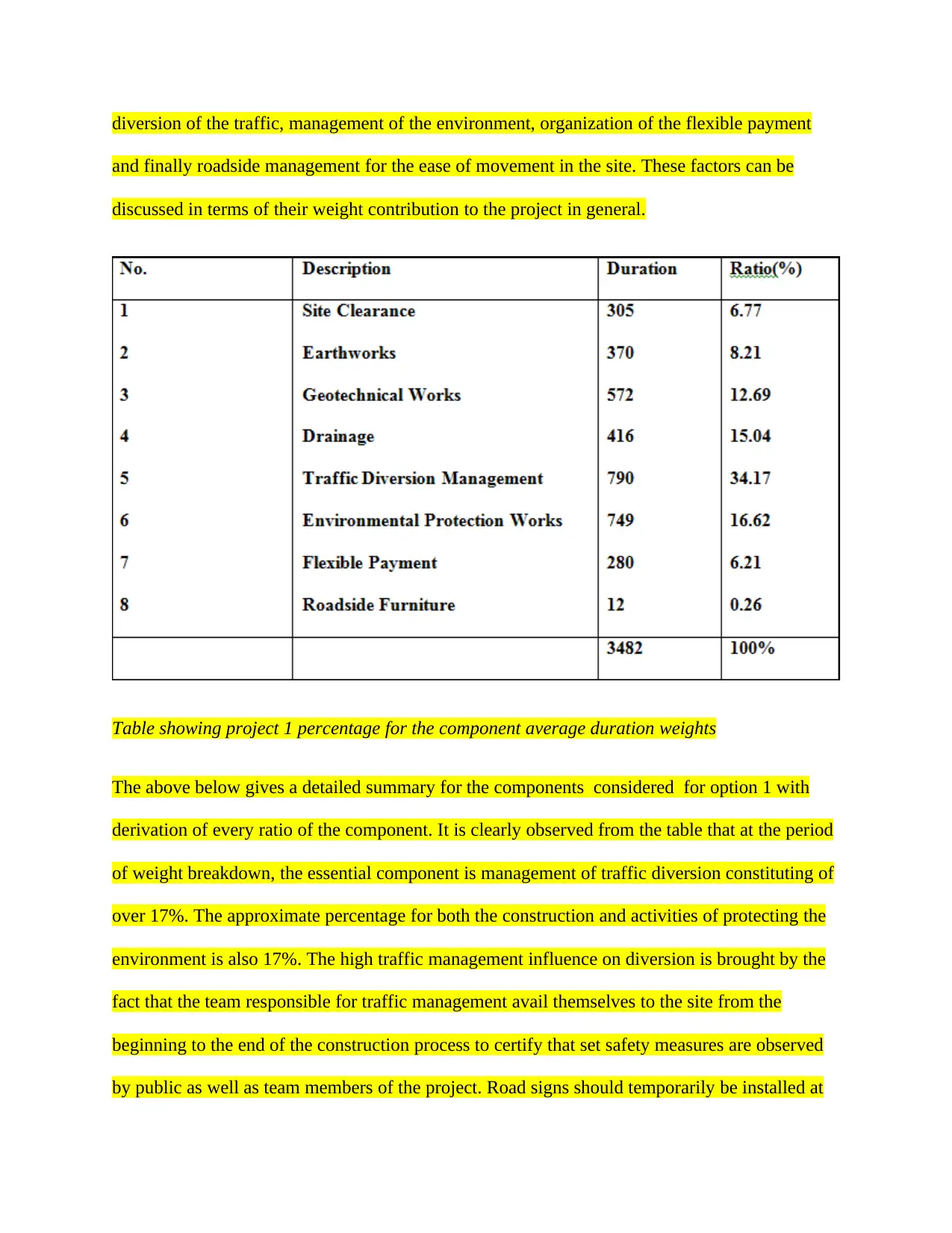
diversion of the traffic, management of the environment, organization of the flexible payment
and finally roadside management for the ease of movement in the site. These factors can be
discussed in terms of their weight contribution to the project in general.
Table showing project 1 percentage for the component average duration weights
The above below gives a detailed summary for the components considered for option 1 with
derivation of every ratio of the component. It is clearly observed from the table that at the period
of weight breakdown, the essential component is management of traffic diversion constituting of
over 17%. The approximate percentage for both the construction and activities of protecting the
environment is also 17%. The high traffic management influence on diversion is brought by the
fact that the team responsible for traffic management avail themselves to the site from the
beginning to the end of the construction process to certify that set safety measures are observed
by public as well as team members of the project. Road signs should temporarily be installed at
and finally roadside management for the ease of movement in the site. These factors can be
discussed in terms of their weight contribution to the project in general.
Table showing project 1 percentage for the component average duration weights
The above below gives a detailed summary for the components considered for option 1 with
derivation of every ratio of the component. It is clearly observed from the table that at the period
of weight breakdown, the essential component is management of traffic diversion constituting of
over 17%. The approximate percentage for both the construction and activities of protecting the
environment is also 17%. The high traffic management influence on diversion is brought by the
fact that the team responsible for traffic management avail themselves to the site from the
beginning to the end of the construction process to certify that set safety measures are observed
by public as well as team members of the project. Road signs should temporarily be installed at
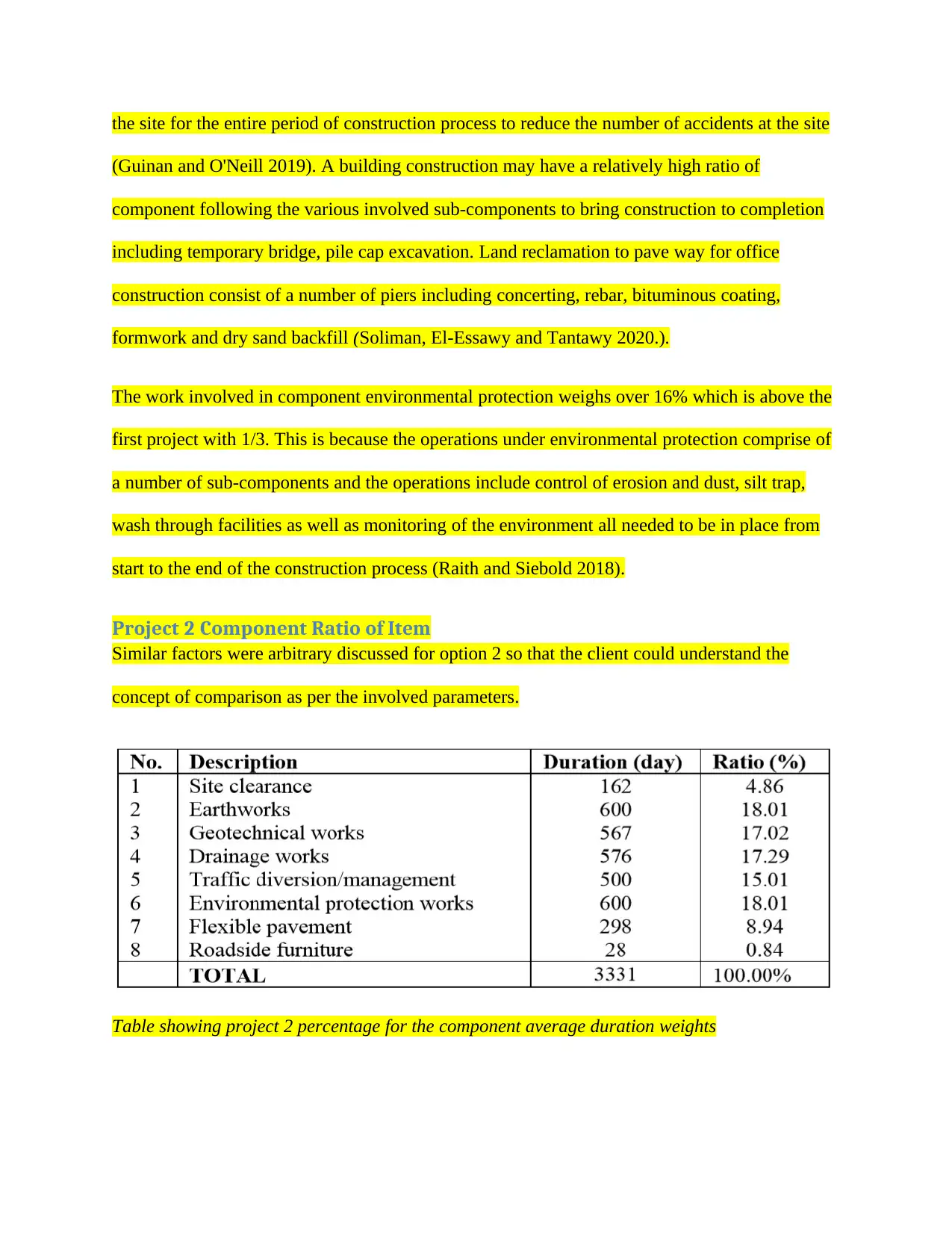
the site for the entire period of construction process to reduce the number of accidents at the site
(Guinan and O'Neill 2019). A building construction may have a relatively high ratio of
component following the various involved sub-components to bring construction to completion
including temporary bridge, pile cap excavation. Land reclamation to pave way for office
construction consist of a number of piers including concerting, rebar, bituminous coating,
formwork and dry sand backfill (Soliman, El-Essawy and Tantawy 2020.).
The work involved in component environmental protection weighs over 16% which is above the
first project with 1/3. This is because the operations under environmental protection comprise of
a number of sub-components and the operations include control of erosion and dust, silt trap,
wash through facilities as well as monitoring of the environment all needed to be in place from
start to the end of the construction process (Raith and Siebold 2018).
Project 2 Component Ratio of Item
Similar factors were arbitrary discussed for option 2 so that the client could understand the
concept of comparison as per the involved parameters.
Table showing project 2 percentage for the component average duration weights
(Guinan and O'Neill 2019). A building construction may have a relatively high ratio of
component following the various involved sub-components to bring construction to completion
including temporary bridge, pile cap excavation. Land reclamation to pave way for office
construction consist of a number of piers including concerting, rebar, bituminous coating,
formwork and dry sand backfill (Soliman, El-Essawy and Tantawy 2020.).
The work involved in component environmental protection weighs over 16% which is above the
first project with 1/3. This is because the operations under environmental protection comprise of
a number of sub-components and the operations include control of erosion and dust, silt trap,
wash through facilities as well as monitoring of the environment all needed to be in place from
start to the end of the construction process (Raith and Siebold 2018).
Project 2 Component Ratio of Item
Similar factors were arbitrary discussed for option 2 so that the client could understand the
concept of comparison as per the involved parameters.
Table showing project 2 percentage for the component average duration weights
⊘ This is a preview!⊘
Do you want full access?
Subscribe today to unlock all pages.

Trusted by 1+ million students worldwide
1 out of 23
Related Documents
Your All-in-One AI-Powered Toolkit for Academic Success.
+13062052269
info@desklib.com
Available 24*7 on WhatsApp / Email
![[object Object]](/_next/static/media/star-bottom.7253800d.svg)
Unlock your academic potential
Copyright © 2020–2025 A2Z Services. All Rights Reserved. Developed and managed by ZUCOL.





